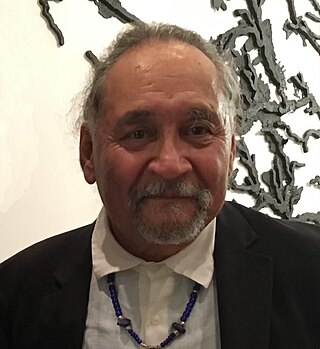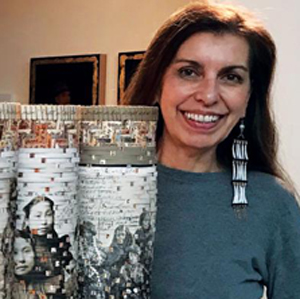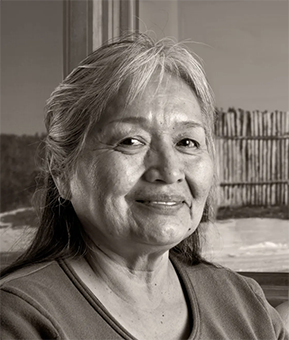
George Morrison was an Ojibwe abstract painter and sculptor from Minnesota. His Ojibwe name was Wah Wah Teh Go Nay Ga Bo. Morrison's work is associated with the Abstract Expressionist movement in the United States.
Teri Greeves is a Native American beadwork artist, living in Santa Fe, New Mexico. She is enrolled in the Kiowa Indian Tribe of Oklahoma.

Jim Denomie was an Ojibwe Native American painter, known for his colorful, at times comical, looks at United States history and Indigenous peoples of the Americas.

Shan Goshorn was an Eastern Band Cherokee artist, who lived in Tulsa, Oklahoma. Her interdisciplinary artwork expresses human rights issues, especially those that affect Native American people today. Goshorn used different media to convey her message, including woven paper baskets, silversmithing, painting, and photography. She is best known for her baskets with Cherokee designs woven with archival paper reproductions of documents, maps, treaties, photographs and other materials that convey both the challenges and triumphs that Native Americans have experienced in the past and are still experiencing today.
Anita Fields is an Osage/Muscogee Native American ceramic and textile artist based in Oklahoma. She is an enrolled citizen of the Osage Nation.

Hazel Belvo is an American painter, educator and women's art advocate.
Andrea Carlson is a mixed-media American visual artist currently based in Chicago. She also maintains a studio space and has a strong artistic presence in Minneapolis–Saint Paul, Minnesota.

Wendy Red Star is an Apsáalooke contemporary multimedia artist born in Billings, Montana, in the United States. Her humorous approach and use of Native American images from traditional media draw the viewer into her work, while also confronting romanticized representations. She juxtaposes popular depictions of Native Americans with authentic cultural and gender identities. Her work has been described as "funny, brash, and surreal".
Dyani White Hawk is a contemporary artist and curator of Sicangu Lakota, German, and Welsh ancestry based out of Minnesota. From 2010 to 2015, White Hawk was a curator for the Minneapolis gallery All My Relations. As an artist, White Hawk's work aesthetic is characterized by a combination of modern abstract painting and traditional Lakota art. White Hawk's pieces reflect both her Western, American upbringing and her indigenous ancestors mediums and modes for creating visual art.
Cara Romero is an American photographer known for her digital photography that examines Indigenous life through a contemporary lens. She lives in both Santa Fe, New Mexico and the Mojave Desert. She is an enrolled citizen of the Chemehuevi Indian Tribe.

Christine McHorse, also known as Christine Nofchissey McHorse, was a Navajo ceramic artist from Santa Fe, New Mexico.
Maria Cristina Tavera ("Tina") is a contemporary Latino artist, curator, and cultural organizer who lives and works in Minneapolis, MN. Influenced by her dual citizenship, as well as her transnational movement between her residing Minnesota and Mexico families, she combines historical and contemporary texts and images from recognizable Latin American myths, legends, and present news. Tavera uses her prints, paintings, installations, and Dia de los Muertos ofrendas, or altars, to explore the way that national and cultural icons symbolize complex identities and can construct shared communities at home and abroad. Her artwork is both humorous and confrontational as she invites her viewers to question constructs of race, gender, ethnicity and national and cultural identities. She has exhibited her artwork and curated shows all around the world, and has artworks permanently installed in several art exhibits throughout Minnesota.
Pao Houa Her is a Hmong-American photographer whose works are primarily centered around the history and lived experiences of the Hmong people. Her's photography consists of greenery and geographic images. She is also a professor at the University of Minnesota and teaches Introduction to Photography.
Natalie Ball is a Klamath/Modoc interdisciplinary artist based in Chiloquin, Oregon.
Melissa Cody is a Navajo textile artist from No Water Mesa, Arizona, United States. Her Germantown Revival style weavings are known for their bold colors and intricate three dimensional patterns. Cody maintains aspects of traditional Navajo tapestries, but also adds her own elements into her work. These elements range from personal tributes to pop culture references.
Maggie Thompson is a Native American textile artist and designer from the Fond du Lac Ojibwe with a focus on "knitwear and tapestry". Her work focuses on her heritage and identity and also addresses cultural appropriation and Native authenticity. She is the director of the Two Rivers Gallery in Minneapolis,
Frank Big Bear is a Native American artist born in Detroit Lakes, Minnesota and is a member of the Minnesota Chippewa Tribe, White Earth Band. As a multimedia Native artist, Big Bear is known for his colorful, abstract display through his drawings, paintings, and photo collages that address various messages about Big Bear's livelihood and worldly perception.
Malcolm Haynie Myers was an American painter, printmaker and professor known primarily for his Intaglio-style engravings. His work is included in numerous museum collections.






